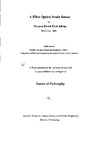A Fibre Optical Strain Sensor
| dc.contributor.author | Allsop, Thomas David Paul | |
| dc.contributor.other | School of Engineering, Computing and Mathematics | en_US |
| dc.date.accessioned | 2013-11-20T14:20:48Z | |
| dc.date.available | 2013-11-20T14:20:48Z | |
| dc.date.issued | 1999 | |
| dc.identifier | NOT AVAILABLE | en_US |
| dc.identifier.uri | http://hdl.handle.net/10026.1/2779 | |
| dc.description.abstract |
Strain-sensing elements, fabricated in standard communications-grade single mode optical fibre, are increasingly being considered for application in structural health monitoring. The reason for this is the numerous advantages demonstrated by these devices compared with traditional indicators. This thesis describes work carried out on optical sensors at the University of Plymouth. The aim of this work was to achieve an optical fibre strain sensing system capable of measuring absolute strain with good resolution and having wide dynamic range, without bulky optical equipment and not susceptible to misalignment due to handling. Earlier work was devoted to study on an intrinsic Fabry-Perot interferometric sensor and an optical phase-shift detection technique. The sensing element investigated relied on the end face of an optical fibre as one mirror and the second mirror being a layer of Titanium Dioxide (TO2). Although some results are included, it was soon realised that this sensor had a number of problems, particularly with fabrication. As no simple solution presented itself, consideration was given to a sensor that made use of the change in reflectance of an intra-core fibre Bragg grating when the grating was subjected to strain. The bulk of work described in this thesis is concerned with this type of sensing element. The grating structure is inherently flexible and a number of structural formats were studied and investigated. The first and simplest grating considered was two linearly chirped Bragg gratings used in a Fabry-Perot configuration (a grating resonator). The sensor was tested using the sensing detection system and although the fabrication problems were overcome absolute strain measurement was unattainable. To achieve this end, a theoretical study of a number of grating structures was carried out using the T-matrix Formalism. Confidence in using this approach was gained by comparing the spectral behaviour of a proposed grating with results, which were given by another theoretical model for the same proposed grating. The outcome of this study was that two structures in particular showed promise with regard to absolutism (the measure of true strain) and linearity. Discussions held with the department of Applied Physics at Aston University about fabrication resulted in one of the proposed designs being abandoned due to difficulties of fabrication. The second structure showed more promise and fabrication attempts were put in hand. This grating is linearly-chirped with a Top-hat function and a sinusoidal perturbation as a taper function of the refractive index modulation. Experiments were performed, data were acquired and system performance for this sensor is presented. The thesis concludes that using such a fibre Bragg grating as the sensing element of a strain sensing system enables it to measure absolute strain without using bulky optical equipment. At present, the resolution of strain is limited by the quality of the grating being fabricated (anomalies on profile), this should improve once the fabrication technique is refined. | en_US |
| dc.description.sponsorship | British Aerospace System and Equipment, BASE and Department of Electronic Engineering and Applied Physics, Aston University | en_US |
| dc.language.iso | en | en_US |
| dc.publisher | University of Plymouth | en_US |
| dc.title | A Fibre Optical Strain Sensor | en_US |
| dc.type | Thesis | |
| plymouth.version | Full version | en_US |
| dc.identifier.doi | http://dx.doi.org/10.24382/4018 | |
| dc.identifier.doi | http://dx.doi.org/10.24382/4018 |
Files in this item
This item appears in the following Collection(s)
-
01 Research Theses Main Collection
Research Theses Main


